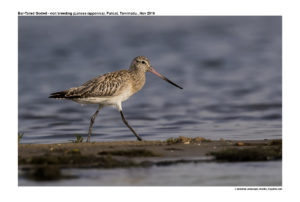Bar-tailed Godwit

Bar-tailed Godwit Limosa lapponica
Etymology:
- Limosa : Latin word muddy derived from limus –
- Lapponica : from Lapland
Vernacular Names : Sind: Susling, Hindi: Pattidar Dum ka Gudera, Gairiya, Jangral, Bi, Nepal: Malgujha, Ben: Jaurali, Guj: Pattapunchh gadera, Rekhapunch gadera, Nano gadera, Te: Tondu ulanka, Mal: Varavalan godwit, Mar: Patteri Shepaticha pantivla
Distribution in India: Widespread Winter Visitor on the Coastline of India
Description: Size of 37-41 cm. It is a medium-sized godwit with slightly upcurved bill and barred tail; in flight, lacks white wing bar and has white underwing. In breeding plumage it has virtually no barring on underparts; upperparts fringed chestnut; shorter legs and bill, and less upright stance than other godwits. Female larger with longer bill; much paler. Non-breeding adult has upperparts pale grey-brown, partly edged whitish; breast turns grey, with fine dark streaking; underparts white.
Habitat: It is found in lowland scrub tundra, forest tundra, rolling uplands, wet river valleys and open larch woodland close to water bodies. After breeding, mainly in intertidal areas, preferably sandy parts of estuaries, inlets, mangrove-fringed lagoons, sheltered bays, wetlands and short-grass meadows.
Food Habits: It eats insects, annelids, molluscs, occasionally seeds and berries during breeding. Non-breeding diet includes smaller annelids, bivalves, crustaceans in intertidal areas, fly larvae in grassland; occasionally tadpoles, small fish and fruits. It feeds by pecking, stitching or probing. Longer-billed females tend to feed in deeper water. Outside breeding season, feeds in flocks.
Breeding Habits: They breed in May- June in Russia. They are monogamous. Nest usually on dry, elevated sites, often between clumps of grass; depression lined with bits of vegetation and lichens. Lays a clutch of 2–5 eggs. The incubation period is 20–21 days. Incubation done by female at night and male during day. Both parents tend young. The fledging period is 28 days; adults depart soon after young fledge